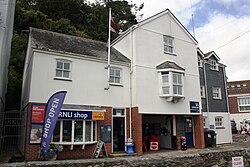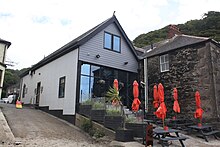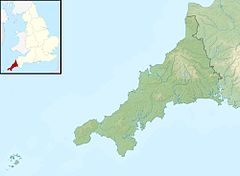Fowey Lifeboat Station
| Fowey Lifeboat Station | |
|---|---|
 | |
| General information | |
| Type | Lifeboat Station |
| Location | Passage Street, PL23 1DE |
| Country | United Kingdom |
| Coordinates | 50°20′21″N 4°37′57″W / 50.3391°N 4.6326°W |
| Opened | 1859 at Polkerris 1922 at Fowey Current boathouse 1997 |
| Owner | |
Fowey Lifeboat Station is the base for Royal National Lifeboat Institution (RNLI) search and rescue operations at Fowey on the south coast of Cornwall in the United Kingdom. The first lifeboat was stationed in the area in 1859 and the present station was opened in 1997. It operates a Trent Class all weather boat (ALB) and a D class (IB1) inshore lifeboat (ILB).
History
[edit]Fowey stands at the mouth of the River Fowey where it forms a natural deep water harbour. The town has a long history of fishing and merchant shipping, although the present quays busy with ships loading china clay were only developed in the 1860s.[1] To the west lies St Austell Bay which includes Par Docks built in the 1840s to handle the mineral traffic from Joseph Treffry's mines and quarries, and Charlestown which had been established about fifty years earlier by Charles Rashleigh.[2] A fatal ship wreck on the Gribben Head between Fowey and St Austell Bay on 6 May 1856 prompted William Rashleigh, a local landowner, to offer the RNLI £50 towards a lifeboat for Fowey and land and building stone for a boathouse.[3]
Polkerris
[edit]
The position of the mouth of the River Fowey meant that it would be nearly impossible to launch a "pulling and sailing" lifeboat (that is, one powered by oars and sails) during the more dangerous storms when the wind blew from the south, and so it was decided to station the lifeboat at Polkerris, a small fishing village with a breakwater on the east side of St Austell Bay. A boathouse was built at the top of the beach for £138 4s (£138.20) on land donated by Rashleigh. The lifeboat was delivered free of charge to Lostwithiel railway station in November 1859 by the Cornwall Railway, and then rowed down the river through Fowey and around St Austell Bay to show it to the public. It was named Catherine Rashleigh after William's wife, who was another of the major donors towards its cost.[4]
The first, six-oared, lifeboat was replaced in 1866 by a larger ten-oared boat, the Rochdale and Catherine Rashleigh, which meant that the boathouse had to be altered.[5] So far the official name had been "Fowey Lifeboat Station" but in 1892 it became "Polkerris". In 1895 it changed again to the compromise of "Polkerris and Fowey", but in 1904 it reverted to "Polkerris".[6] During a launch in 1908 a chain broke, and an inspection of the station found that the gradient changed three times in the boathouse and slipway; this was altered by February 1909 to make launching safer.[7] Several requests were made around this time for a lifeboat be stationed at Fowey, but the RNLI decided that the one at Polkerris was operating efficiently. Conditions changed following World War I as the RNLI brought in plans for a more efficient service with motor lifeboats, when it was decided that Fowey would be a better location for such a boat. Polkerris Lifeboat Station closed in 1922, after which it was converted into a café.[8]
Fowey
[edit]Despite the promise of a motor lifeboat, the first boat stationed at Fowey was a 12-oared pulling and sailing boat. It was kept moored afloat in the river near Town Quay where the crew had use of a building on the waterfront. In August 1928 the boat was declared unfit for service and so a 45 ft 6in Watson-class motor lifeboat that was intended for Thurso Lifeboat Station, the H.C.J. (ON 708), was stationed at Fowey for a few months until Fowey's own boat, the C.D.E.C. (ON 712), arrived and went on station on 6 December. Fitted with two 40 bhp engines, it had a maximum speed of 8 knots (15 km/h) and could operate up to 78 nautical miles (144 km) from her station.[9] C.D.E.C. served at Fowey until November 1954, launching on service 65 times and saving 49 lives.[10] On 24 November 1954 Fowey's brand new 46 ft 9in Watson-class Deneys Reitz (ON 919) went on station and spent her entire career at Fowey until withdrawal in May 1980. She had launched on service 155 times, saving 36 lives.
Deneys Reitz replacement was a much older Relief fleet 46 ft Watson-class, the 1946 built Gertrude (ON 847) which was at Fowey for eighteen months until November 1981. The former St. Marys 46 ft 9in Watson-class Guy and Clare Hunter (ON 926) was the next boat, but served for less than two months before being sent to Penlee to replace the ill-fated Solomon Browne. Another Relief fleet 46 ft 9in Watson, Charles Henry Ashley (ON 866) then filled the breach, but on 16 October 1982 a new type of craft took up station, the first of its class to be put into service. The Leonore Chilcott (ON 1083) was a Brede class lifeboat. Powered by two 203 hp Caterpillar diesel engines, these "intermediate" lifeboats were not able to operate in the storms above Force 8, but otherwise could operate at up to 20 knots (37 km/h) and had a range of 140 nautical miles (260 km).[11] She served for five years before being replaced by the older but larger ex-Plymouth Waveney-class Thomas Forehead & Mary Rowse II (ON 1028). The Waveney served for more than 81⁄2 years, launching on service 169 times and saving 35 lives before being replaced by the current Trent-class in October 1996.
The RNLI started to provide small, fast inshore rescue boats in the 1960s, but it was not until August 1996 that one was stationed at Fowey. The harbour at Mevagissey had been considered as a possible ILB station but no suitable site could be found. The small D Class inflatable was initially kept in a wooden container at Berrill's Yard and launched using a davit near the ALB's moorings which had recently been moved from Town Quay. On 4 October 1997 a unique triple ceremony took place at Fowey to bring into service not just a new purpose-built lifeboat station Berrill's Yard at but also to christen the station's two newest lifeboats, Trent Class ALB 14-18 Maurice and Joyce Hardy (ON 1222) and D Class ILB Olive Herbert (D-526).[12]
Service awards
[edit]The volunteer crews of the RNLI do not expect reward or recognition for their work, but the records include many rescues that have been recognised by letters, certificates and medals from the RNLI management. The following are just some of the most notable at Fowey.
Two large sailing ships ran aground in a strong gale near Par harbour on 25 November 1865. The Catherine Rashleigh put to sea from Polkerris under the command of Joshua Heath, but lost four oars before she reached the ships. The crew of one then launched their own small boat, but this broke away with just one man and the ship's cat on board. The lifeboat managed to reach them and took them to Par where they took on some replacement oars and returned to the grounded ships. After landing 13 men from the larger vessel at Par, and taking on two fresh rowers, returned to rescue the remaining nine people. The whole rescue took five hours and resulted in Joshua Heath being awarded a silver medal by the RNLI.[13]
Before dawn on 23 March 1947 distress signals were reported near Par Sands. Relief Lifeboat The Brothers set out from Fowey at 04:40. After an hour's search through rain-swept heavy seas a sunken ship was found near Killyvarder Rock, with the crew gathered on a small part that was still out of the water. The tide was rising and so the lifeboat swiftly moved in but had to haul the men on a rope through the sea. Lifeboat Coxswain John Watters was awarded a bronze medal and the efforts of his crew were also recognised.[14]
The following are all the awards that have been made at Polkerris and Fowey:[15]
- Lt John Else RN – 1826
- Thomas Crosswell, Chief Officer of Coastguard – 1829
- Captain George L Norcock RN, coastguard – 1856
- Thomas Henwood – 1856
- Richard Jones – 1856
- Joshua Heath, Coxswain – 1865
- William Robins – 1893
- Edwin Robins – 1893
- George Bishop – 1893
- Frederick Perring – 1893
- Mr William Penrose – 1905
- Joseph Watters, Coxswain – 1947
- The Thanks of the Institution inscribed on Vellum
- J Turpin, Assistant Mechanic – 1958
- A Framed Letter of Thanks signed by the Chairman of the Institution
- Keith Stuart, Coxswain – 2006
Description
[edit]The three-storey lifeboat station was built in 1997 in a style that blends with the older buildings around it. The gabled central section has covered facilities for the IRB at ground floor level and a small bow window at first floor level. On the left is a two-storey wing which includes a fund-raising RNLI shop. The right hand wing is three storeys high. It is on the landward side of Passage Street opposite the IRB's launch site and the ALB's moorings.[12]
Area of operation
[edit]The RNLI aims to reach any casualty up to 50 miles (80 km) from its stations, and within two hours in good weather. To do this the Trent class lifeboat at Fowey has an operating range of 250 nautical miles (460 km) and a top speed of 25 knots (46 km/h).[16] Adjacent lifeboats are an ILB at Looe Lifeboat Station and an ALB at Plymouth Lifeboat Station to the East, and both and ALB and ILB at Falmouth Lifeboat Station to the West.[17]
Polkerris and Fowey lifeboats
[edit]-
Charles Henry Ashley (1982)
-
Maurice and Joyce Hardy (from 1996)
-
Olive Three (from 2017)
Pulling and sailing lifeboats
[edit]| At Polkerris | ON | Name | Built | Class | Comments |
|---|---|---|---|---|---|
| 1859–1866 | — | Catherine Rashleigh | 1859 | Peake | Broken up 1867[18] |
| 1866–1887 | — | Rochdale and Catherine Rashleigh | 1866 | Self-righter | Renamed Rochdale in 1873 and then Arthur Hill in 1879. Sold out of service 1891.[19] |
| 1887–1904 | 136 | Arthur Hill | 1887 | Self-righter | Broken up 1904.[20][21] |
| 1904–1922 | 515 | James, William and Caroline Courtenay | 1904 | Watson | Sold and still in use as yacht Gray Fox in 2023.[22][23] |
| 1922–1926 | 394 | James, William and Caroline Courteney | 1897 | Self-righter | Initially stationed at Walmer and named Civil Service No.4.[24][25] |
| 1926–1928 | 505 | Reserve No.4C | 1903 | Watson | Initially stationed at Littlehaven and named William Roberts. Sold and used as yacht until 2009.[26][23] |
Motor lifeboats
[edit]| At Fowey | ON | Op. No. | Name | Built | Class | Comments |
|---|---|---|---|---|---|---|
| 1928 | 708 | — | H.C.J. | 1928 | Watson | Later stationed at Holyhead and Thurso. Sold in 1962; reported in 2023 to be used as a pleasure boat named Seawitch at Castletown, Isle of Man.[27][28] |
| 1928–1954 | 712 | — | C.D.E.C. | 1928 | Watson | Sold in 1959 and used as a workboat named Thameserver but in 2023 reported to be out of use at Leigh-on-Sea.[29][28] |
| 1954–1980 | 919 | — | Deneys Reitz | 1954 | Watson | Sold converted for use as a cruiser, reported to be in Sweden in 2018.[30][31] |
| 1980–1981 | 847 | — | Gertrude | 1946 | Watson | Initially stationed at Holy Island. Sold and in use at Mevagissey.[32][33] |
| 1981–1982 | 926 | — | Guy and Clare Hunter | 1955 | Watson | Initially stationed at St Mary's. Sold in 1988 and in use as a pleasure boat at Donaghadee.[32][31] |
| 1982 | 866 | — | Charles Henry Ashley | 1949 | Watson | Initially stationed at Porthdinllaen. Sold in 1987 and now working in Paris as Charles Ashley.[32][34] |
| 1982–1987 | 1083 | 33-03 | Leonore Chilcott | 1982 | Brede | Sold in 1990. After working as a survey boat in Kent it is now a pilot boat at Braye, Alderney.[11][35] |
| 1987–1996 | 1028 | 44-010 | Thomas Foreland and Mary Rowse II | 1974 | Waveney | Initially stationed at Plymouth until transferred to Fowey. Sold to New Zealand Coastguard in 1999 as lifeboat Westgate Rescue at New Plymouth but now retired and in private use at Fiordland.[36][35] |
| 1996– | 1222 | 14-18 | Maurice and Joyce Hardy | 1996 | Trent | [37][38] |
Inshore lifeboats
[edit]| At Fowey | Op. No. | Name | Class | Model | Comments |
|---|---|---|---|---|---|
| 1996–1997 | D-390 | Tiger D | D | EA16 | Initially stationed at porthcawl in 1989.[39][40] |
| 1997 | D-433 | Marjorie | D | EA16 | Initially deployed as a relief lifeboat in 1992.[39][41] |
| 1997–2007 | D-526 | Olive Herbert | D | EA16 | [39][42] |
| 2007-2017 | D-681 | Olive Two | D | IB1 | [43] |
| 2013-2017 | A-68 | Malcolm Hawkesford II | A | Arancia | Used as a boarding boat.[44] |
| 2017– | D-817 | Olive Three | D | IB1 | [45] |
See also
[edit]References
[edit]- ^ Keast, John (1987) [1950]. The Story of Fowey. Redruth: Dyllansow Truran. ISBN 1-85022-035-2.
- ^ Roddis, Roland (1951). Cornish Harbours. London: Christopher Johnson Publishers. pp. 37–46.
- ^ Leach, Nicholas (2002). Fowey Lifeboats, an Illustrated History. Stroud: Tempus Publishing. p. 13. ISBN 0-7524-2378-9.
- ^ Leach 2002, p. 14.
- ^ Leach 2002, p. 17.
- ^ Leach 2002, p. 28.
- ^ Leach 2002, p. 22.
- ^ Leach 2002, pp. 26–30.
- ^ Leach 2002, pp. 30–33.
- ^ Leach, Nicholas (2005). RNLI Motor Lifeboats. Ashbourne: Landmark Publishing. p. 38. ISBN 1-84306-201-1.
- ^ a b Leach 2002, pp. 63–74.
- ^ a b Leach 2002, pp. 93–112.
- ^ Leach 2002, p. 16.
- ^ Leach 2002, pp. 40–41.
- ^ "Fowey's station history". RNLI. Retrieved 7 February 2024.
- ^ Wake-Walker, Edward (2008). The Lifeboats Story. Stroud: Sutton Publishing. p. 111. ISBN 978-0-7509-4858-6.
- ^ Leonard, Richie; Denton, Tony (2024). Lifeboat Enthusiasts Handbook 2024. Lifeboat Enthusiasts Society. p. 115.
- ^ Leach 2002, pp. 14–17.
- ^ Leach 2002, pp. 17–19.
- ^ Leach 2002, pp. 19–20.
- ^ Leonard & Denton 2024, pp. 8–9.
- ^ Leach 2002, pp. 20–25.
- ^ a b Leonard & Denton 2024, pp. 22–23.
- ^ Leach 2002, pp. 30–31.
- ^ Leonard & Denton 2024, pp. 18–19.
- ^ Leach 2002, p. 31.
- ^ Leach 2002, p. 32.
- ^ a b Leonard & Denton 2024, pp. 30–31.
- ^ Leach 2002, pp. 32–43.
- ^ Leach 2002, pp. 45–59.
- ^ a b Leonard & Denton 2024, pp. 40–41.
- ^ a b c Leach 2002, pp. 59–61.
- ^ Leonard & Denton 2024, pp. 36–37.
- ^ Leonard & Denton 2024, pp. 38–39.
- ^ a b Leonard & Denton 2024, pp. 48–49.
- ^ Leach 2002, pp. 75–93.
- ^ Leach 2002, pp. 108–139.
- ^ Leonard & Denton 2024, p. 54.
- ^ a b c Leach 2002, pp. 96–98.
- ^ Leonard & Denton 2024, p. 78.
- ^ Leonard & Denton 2024, p. 79.
- ^ Leonard & Denton 2024, p. 81.
- ^ Leonard & Denton 2024, p. 83.
- ^ Leonard & Denton 2024, p. 88.
- ^ Leonard & Denton 2024, p. 86.




